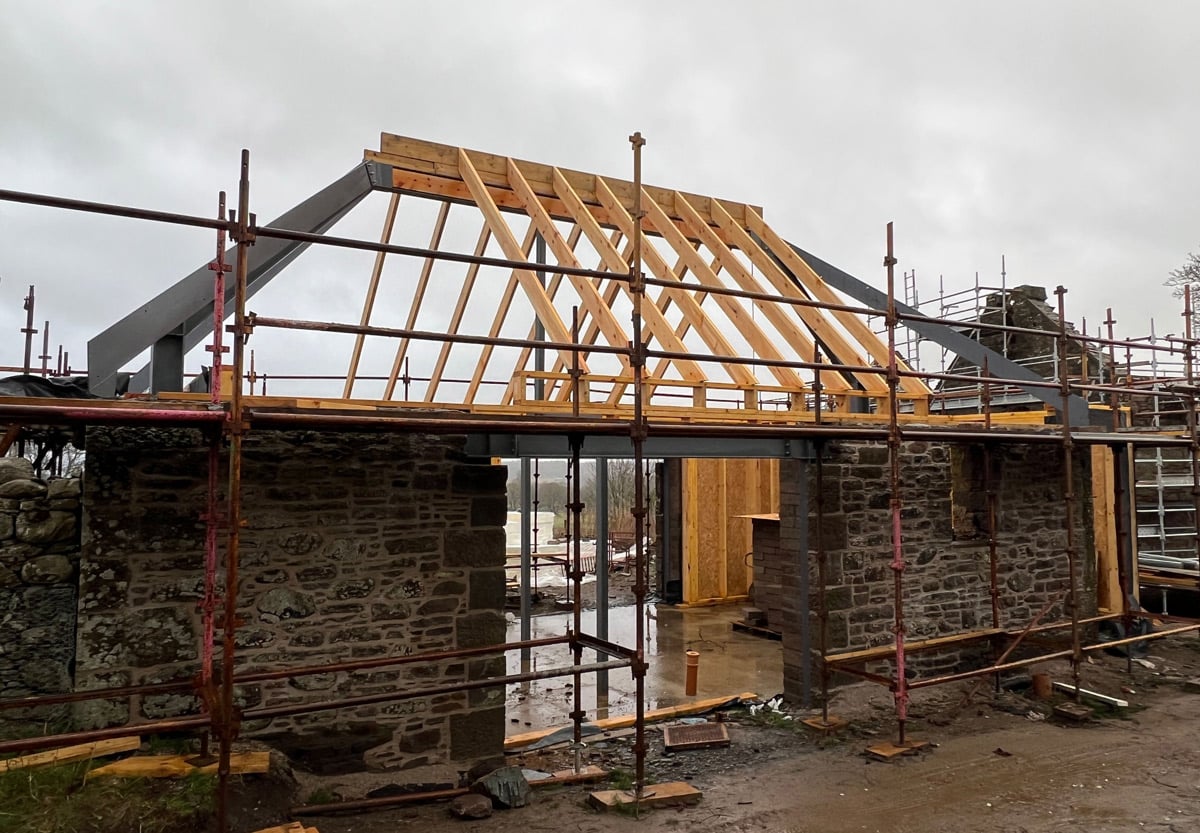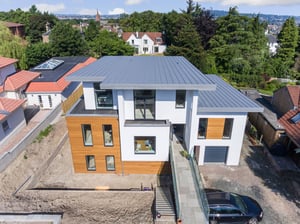Retrofitting a house can be an exciting endeavour for homeowners, offering the opportunity to blend the charm of an existing space with the advantages of modern technology and enhanced comfort.
In this article, we will delve into the basics of retrofitting your home, guiding you on where to begin and primarily focusing on improving internal comfort, energy efficiency, and overall livability.
1. INITIAL EVALUATION
The starting point of any retrofit project is to identify areas in your home that require improvement. Older properties often suffer from issues like drafts, inadequate insulation, and outdated heating systems, which can lead to increased heating costs and discomfort. Unlike modern constructions that adhere to current building regulations, older homes are frequently not airtight and lack proper insulation. These issues can extend to the specifications of windows and even to open fireplaces that haven’t been sealed or underutilised gas heating systems, which are becoming increasingly expensive. To start your retrofit project, it’s crucial to identify and assess these weak points in your current home that require improvement.
At the basic level, begin your assessment by taking a notepad and walking through your home, identifying its key issues. We strongly recommend involving surveyors at this stage who can visit your property to confirm these issues. There may often be concealed problems with your property, such as timber rot in the roof or roof covering and flashing issues, leading to leaks and potential structural concerns. These structural issues are interrelated with the draftiness of your house, which can be influenced by the construction method.
Moisture may seep through gaps and imperfections in your construction, particularly around windows or in building corners, leading to mould growth. Beyond the negative impact on your health, these problems can also compromise the integrity of your home’s structure. This initial assessment is a crucial starting point for planning your retrofit project.
2. BUDGET AND PRIORITISATION:
Your budget will play a significant role in determining the scope of your retrofit project. Often, it involves enhancing the airtightness of your building, addressing the thermal performance of your existing structure, and possibly replacing windows, especially if they are single-glazed units. To put the impact of windows into perspective, consider that in a new build, even the best windows on the market are still approximately 600 times less thermally efficient than the actual wall. This underscores the importance of addressing windows in your retrofit project.
While these improvements represent a substantial investment, you may be eligible for grants, especially in Scotland, where grants are available for renewable heating sources. If your budget is limited, consider staging the works over several years. For example, focus on airtightness and windows in the first year, then move on to insulation upgrades in the second year. This phased approach allows you to adapt to your budget constraints while gradually improving your home’s energy efficiency and comfort.
3. CONSIDER PROFESSIONAL ASSESSMENT:
Taking your retrofit to the next level involves engaging professionals to thoroughly assess your home. This advanced approach includes the use of thermal imaging to pinpoint weak areas within the building envelope. Additionally, you can hire consultants to perform preliminary Passive House Planning Package (PHPP) calculations on your home.
These calculations provide valuable insights into your current heating demand and suggest the additional insulation required to reduce your energy bills significantly.

If you’re focusing on retrofitting your home to comply with building regulations without investing in additional professional services like PHPP, your aim would be to align your project with the current building regulations. It’s worth noting that recent changes in regulations are more stringent, especially concerning new builds, retrofits, and extensions.
However, achieving compliance can be challenging, especially if you have an older stone-built house, as it may necessitate substantial internal insulation.
This can potentially reduce the usable internal space and aesthetics of your home. Striking a balance between compliance and maintaining the attractiveness and usability of your space is essential. To achieve this, you should collaborate closely with professionals who understand your needs and can guide you towards the most optimal retrofitting solution.
5. BALANCING ENERGY EFFICIENCY WITH AESTHETIC IMPROVEMENTS
When embarking on a home retrofit, it’s essential to consider various aspects beyond just energy efficiency. You may also have aesthetic improvements and changes to your living space in mind. These considerations can significantly impact the way you plan and execute your retrofit project.
For instance, if you’re contemplating internal alterations like opening up your kitchen to your living space, it makes sense to coordinate these changes with your energy efficiency upgrades. By doing so, you can avoid having tradespeople come in at a later stage, which might disrupt the finishes already in place. Therefore, staging the works in your retrofit is crucial, and you should approach it step by step, considering both energy efficiency and aesthetics.
Replacing windows is another example of a retrofit element that can impact your interior finishes. To ensure proper installation and airtightness, you may need to strip the internal finishes. Airtightness is crucial for energy efficiency, and using airtight tape around the windows can help eliminate drafts and weak points.
The approach to achieving airtightness can vary depending on whether you’re renovating the building’s exterior or conducting a deep retrofit from the inside. In a deep retrofit, you have easier access to various nooks and crannies, such as under timber floors. Even seemingly simple tasks like changing carpets can provide opportunities to improve airtightness by addressing issues like ventilated floors.
In summary, a comprehensive approach to your retrofit project involves thinking holistically about all the planned works and how they can collectively enhance your home’s energy efficiency and comfort while achieving your desired aesthetics and living space improvements.

6. INSULATION AND WINDOWS IMPROVEMENTS
When considering upgrades for your home, it’s essential to assess various aspects like insulation and windows. The extent of these upgrades depends on your property’s current condition. You might find that some parts of your house, such as the roof, already have insulation, while others, like the walls and floors, lack it. Thermal imaging can be a valuable tool for uncovering hidden issues.
First, identify your home’s construction method to determine the right insulation material. For instance, avoid applying PIR insulation directly to stone walls without proper ventilation, as this can lead to moisture problems. If you prioritize eco-friendliness and breathability, you could consider wood fibre insulation. However, keep in mind that it may require thicker installation to achieve the same performance as PIR insulation.
When it comes to windows, replacing single-glazed windows with double or triple-glazing is a worthwhile investment for improving thermal comfort and energy efficiency. Proper sealing, weather stripping, and door sweeps are crucial to eliminate drafts. Investing in windows and doors is fundamental for enhancing your property’s livability and reducing heating costs.
Engaging with professionals, like architects or energy consultants, can help you make informed decisions. A holistic approach, addressing insulation, windows, and doors, is key to creating a comfortable and energy-efficient home.
7. HEATING SYSTEM UPGRADE:
In terms of updating your heating system, safety is a top priority. Regular boiler assessments and annual check-ups are essential. If your boiler is relatively new, it should be efficient. However, if you plan on making upgrades or extending your property, consider consulting a heating engineer to explore the possibility of installing a renewable air-source heat pump. There are grants available for these eco-friendly heating solutions, which align with the current emphasis on sustainability and changing building regulations.
Additionally, the government is focusing on encouraging upgrades to existing properties, which can be important to include in your article. Now, let’s discuss the installation of a smart thermostat for better temperature control, which is a fundamental improvement.
When contemplating a high-level change to your heating system, keep in mind that this can be a significant investment. However, there are grant options available to help offset the costs. If your current boiler is still functional, you might consider making this change in a few years, but do stay updated on the availability of grants, as circumstances can change.
Moreover, if you plan to extend your property in the future, ensure that your heating system can efficiently heat the additional space.

8. SMART HOME INTEGRATION AND ENERGY MONITORING:
Integrating smart home technology during a retrofit offers numerous benefits. It enhances convenience, allowing for voice-activated control of various aspects, such as lighting and thermostats. This technology also boosts energy efficiency, thanks to smart thermostats that enable precise control and scheduling.
You can improve security with features like smart locks and doorbell cameras, providing real-time monitoring and remote access for enhanced safety. Energy monitoring tools offer insights into appliance energy usage, promoting informed decisions to save energy and reduce costs.
Centralised control through a single hub streamlines the user experience, and while there is an initial investment, it’s offset by long-term energy savings and increased home value. Customisation options cater to specific needs and preferences, and smart tech can benefit individuals with disabilities by providing voice commands and remote control for greater independence.
9. SAFETY AND COMPLIANCE:
Upgrading the electrical panel during a retrofit is crucial, especially if the existing panel is old and doesn’t meet current safety standards. This ensures your home’s electrical system is up to code and reduces the risk of electrical fires. Installing smoke detectors is also essential for fire safety, and recent government regulations require a minimum of two smoke detectors in properties, typically placed in corridors and kitchens.
You might also consider adding a heat detector or carbon monoxide detector if you have a gas boiler. While some homes may opt for a fire sprinkler system, it’s generally seen as excessive for most retrofits. Simple fire extinguishers in key areas can also enhance safety.
Functional upgrades to your home’s electrical system can significantly improve safety and functionality, but it’s essential to work with a qualified electrician to ensure compliance with local regulations and safety standards.

10. AESTHETIC AND FUNCTIONAL UPGRADES:
When it comes to basic retrofitting, it’s all about improving your home’s interior finishes. This includes painting to freshen up the look, changing flooring, and considering eco-friendly paint options to enhance indoor air quality. You can also explore interior design options to match your preferred style, from recycling old furniture to creating mood boards for inspiration.
Thinking about the space itself, open floor plans are a popular trend. However, ensuring that any walls you plan to remove are not load-bearing is crucial. You’ll need a structural engineer’s assessment and building approval if they are.
In conclusion, retrofitting your home is an exciting journey that combines preserving its charm with modern comfort enhancements. This article has guided you through the process, emphasizing the initial evaluation to identify improvement areas and the importance of budget considerations. We’ve highlighted the significance of engaging professionals, meeting building regulations, and striking a balance between energy efficiency and aesthetics.
Upgrading your heating system for safety and efficiency, embracing smart home technology, ensuring safety and compliance, and making aesthetic and functional improvements are essential aspects of retrofitting. Tailoring these steps to your specific needs and budget allows you to create a greener, more comfortable home that aligns with modern standards. Remember that each retrofit project is unique, so approach it with careful planning and prioritisation.
For more Self Build advice, take a look at the learning centre or follow the link below to arrange a free initial consultation with one of our team.





